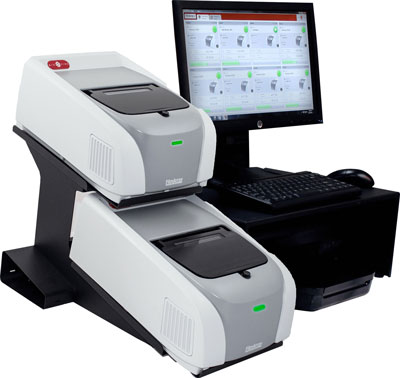The FilmArray system uses PCR cloning and HRM (high resolution melting) technology – a molecular biology technique which allows detection of pathogens through traces left on the DNA strings called a “melting curve”. HRM analysis technology helps to quickly and accurately identify genetic components in a variety of samples.

The FilmArray system identifies most of the causes of respiratory and intestinal diseases, encephalitis/meningitis and sepsis, with the following advantages:
- Fast results with high accuracy
- Significant reduction (84%) of the time compared with traditional analysis methods
- Reduces unnecessary antibiotic treatment
- Significant savings in cost compared with conventional methods.
The FilmArray system consists of four test groups:
FilmArray Blood Culture ID (BCID) – Identifying 27 pathogens of septicaemia in one hour
In the United States, more than one million cases of sepsis occur each year, of which more than a quarter are fatal. Worldwide, around 15 to 19 million cases occur every year, of which 80 per cent of people in the low and middle income bracket die (AJRCCM 2016). Because sepsis kills more people than breast cancer, prostate cancer and HIV combined, researchers have sought ways more sophisticated ways to treat it, as well as prevent it.
FilmArray Blood Culture ID (BCID) is a fast, accurate, FDA-approved analysis technology that allows detection of 27 pathogens of septicemia in just one hour, significantly shortening diagnostic time (which usually takes several days using traditional culture methods). FilmArray BCID helps to identify the cause of sepsis from positive blood cultures significantly earlier than traditional methods. The testing system allows detection of 27 pathogens including gram-negative, gram-positive, yeast and three related resistance genes for early diagnosis and timely treatment of sepsis, reducing mortality rate and risk of other consequences.
FilmArray Meningitis (ME) – Detects 14 agents which cause encephalitis/meningitis
While traditional tests for encephalitis/meningitis take a long time to conduct (24 to 72 hours for bacteria, 24 to 120 hours for viruses), FilmArray (ME) encephalitis/ meningitis uses HRM technology to provide results one hour after performing the test. FilmArray (ME) comprehensively detects 14 common causes (bacteria, viruses, and fungi) associated with encephalitis and meningitis with only 0.2 ml of cerebrospinal fluid (CSF), accelerating diagnosis and treatment, giving patients a better chance of survival.

FilmArray Respiratory Panel (RP) – Detecting 20 causes of upper respiratory tract infection
FilmArray RP can detect up to 20 pathogens, including viruses and bacteria, on just one sample rather than requiring multiple samples (which is required with traditional methods). Rapid and accurate identification of pathogens can significantly improve unnecessary antibiotic treatment, which accounts for about 55 per cent of prescriptions in outpatient respiratory infections, as well as support more effective treatment.
FilmArray Gastrointestinal (GI) – Rapidly detects 22 causes of gastrointestinal infections
FilmArray GI identifies the 22 most common pathogens, including bacteria, viruses and parasites, associated with gastroenteritis from a single sample via an easy-to-use reagent, delivering results in about an hour.



